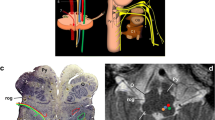Abstract
This article, for both researchers and clinicians, presents an overview of the lingual nerve and highlights how new insights into human anatomical variability can be gained by integrating fine dissection of cadavers with neuroanatomical approaches, microscopic studies, and morphometric techniques. Textbooks mainly provide descriptions of the typical or common gross anatomical appearance of structures in the human body with little reference to the nature and extent of variation that may be encountered within and between populations. Furthermore, few texts attempt to integrate descriptions of the regional distribution and branching of neural structures with their central connections or their microscopic anatomy. Using the lingual nerve as an example from the head and neck region, we show that there is still an important place for detailed fine dissections of human cadavers when they are also integrated with morphometric techniques applied to data representing observed variation at both macro- and micro-levels. It is essential that health professionals have a sound understanding of the nature and extent of anatomical variation displayed normally by their patients so that they can perform procedures, such as local anaesthesia and surgery, safely and also be able to correctly diagnose pathology when it is present.





Similar content being viewed by others
References
Redwood CJ, Townsend GC. The dead center of the dental curriculum: changing attitudes of dental students during dissection. J Dent Educ. 2011;75:1333–44.
Sinnatamby CS. Last’s anatomy regional and applied. 11th ed. Edinburgh: Churchill Livingstone; 2006.
Warwick R, Williams PL. Gray’s anatomy. 35th ed. London: Longman; 1973.
Romanes GJ. The peripheral nervous system. In: Romanes GJ, editor. Cunningham’s textbook of anatomy. 12th ed. Oxford: Oxford University Press; 1981. pp. 739–827.
Khoury J, Mihailidis S, Ghabriel M, Townsend G. Anatomical relationships within the human pterygomandibular space: relevance to local anesthesia. Clin Anat. 2010;23:936–44.
Khoury JN, Mihailidis S, Ghabriel M, Townsend G. Applied anatomy of the pterygomandibular space: improving the success of inferior alveolar nerve blocks. Aust Dent J. 2011;56:112–21.
Kiernan JA. Barr’s the human nervous system: an anatomical view point. 9th ed. Baltimore: Lippincott Williams & Wilkins; 2009.
Blumenfeld H. Neuroanatomy through clinical cases. 2nd ed. Massachusetts: Sinauer Asociates Inc; 2010.
Wilkinson JL. Neuroanatomy for medical students. 2nd ed. Oxford: Butterworth Heinemann; 1992.
Martin JH. Neuroanatomy text and Atlas. 4th ed. New York: McGraw Hill; 2012.
Turlough FitzGerald MJ, Gruener G, Muti E. Clinical neuroanatomy and neuroscience. 5th ed. Philadelphia: Elsevier; 2007.
Young PA, Young PH, Tolbert DL. Basic clinical neuroscience. 2nd ed. Philadelphia: Lippincott Williams & Wilkins; 2008.
Takezawa K, Townsend G, Ghabriel M. The facial nerve: anatomy and associated disorders for oral health professionals. Odontology. 2018;106(2):.103–16. https://doi.org/10.1007/s10266-017-0330-5.
Tan VL, Andrawos A, Ghabriel MN, Townsend GC. Applied anatomy of the lingual nerve: relevance to dental anaesthesia. Arch Oral biol. 2014;59:324–35.
Bell MA, Weddell AG. A descriptive study of the blood vessels of the sciatic nerve in the rat, man and other mammals. Brain. 1984;107:871–98.
Al-Amery SM, Nambiar P, Naidu M, Ngeow WC. Variation in Lingual Nerve Course: A human cadaveric study. PLOS one. 2016;11:e0162773. https://doi.org/10.1371/journal.pone.0162773.
Mendes MB de, Carvalho Leite Leal Nunes CM, de Almeida Lopes MC. Anatomical relationship of lingual nerve to the region of mandibular third molar. J Oral Maxillofac Res. 2013;4:e2. https://doi.org/10.5037/jomr.2013.4402.
Kim SY, Hu KS, Chung IH, Lee EW, Kim HJ. Topographic anatomy of the lingual nerve and variations in communication pattern of the mandibular nerve branches. Surg Radiol Anat. 2004;26:128–35.
Takezawa K, Kageyama I. Nerve fiber analysis on the morphology of the lingual nerve. Anat Sci Int. 2015;90:298–302.
Harris EF, Smith RN. Accounting for measurement error: a critical but often overlooked process. Arch Oral biol. 2009;54(Suppl 1):107-17.
Anderson PJ, Yong R, Surman TL, Rajion ZA, Ranjitkar S. Application of three-dimensional computed tomography in craniofacial clinical practice and research. Aust Dent J. 2014; 59(Suppl 1):174–85.
Yong R, Ranjitkar S, Townsend GC, Smith RN, Evans AR, Hughes TE, Lekkas D, Brook AH. Dental phenomics: advancing genotype to phenotype correlations in craniofacial research. Aust Dent J. 2014; 59(Suppl 1):34–47.
Townsend G, Brook A, Yong R, Hughes T. Tooth classes, field concepts, and symmetry. In: Irish JD, Scott GR, editors. A companion to dental anthropology. Oxford: Wiley. 2016. Ch. 13: pp. 172–188.
Acknowledgements
We would like to thank the staff of the Ray Last Anatomy Laboratory at the University of Adelaide for their technical assistance. Dr. Kojiro Takezawa received support from School of Life Dentistry at Niigata, Japan, to undertake post-doctoral studies in the Adelaide Dental School. We would like to thank the reviewers for suggesting the addition of a summary table and providing an example.
Author information
Authors and Affiliations
Corresponding author
Ethics declarations
Conflict of interest
The authors declare that they have no conflict of interest.
Rights and permissions
About this article
Cite this article
Ghabriel, M., Takezawa, K. & Townsend, G. The lingual nerve: overview and new insights into anatomical variability based on fine dissection using human cadavers. Odontology 107, 1–9 (2019). https://doi.org/10.1007/s10266-018-0371-4
Received:
Accepted:
Published:
Issue Date:
DOI: https://doi.org/10.1007/s10266-018-0371-4




